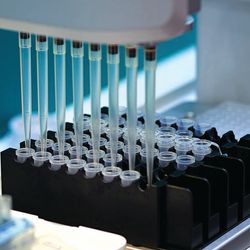Renovating a Lab to Support End-to-End Automation
Lab managers play a crucial role in the design and implementation process
In approaching a lab renovation project to accommodate automation, it is important to address how automation integrates into a holistic system. Automation impacts diagnostic equipment, discovery equipment, and building systems. Consolidating automation systems into a comprehensive and functional enterprise that effectively interfaces with all those aspects of the lab is a significant challenge for the lab manager.
At the beginning of the renovation process to support automation, the lab manager must assume the role of “automation gatekeeper.” With this new role, an important item to consider is that through the integration of automation, the lab manager can fully understand the processes and conditions in the environment and guide them in an integrated manner. In developing a strategy, it is essential to note that implementation is in two parts: the first being the physical equipment to be housed in the lab space, and the second being the computer-based drivers of the equipment and their location, along with the utility routing to the equipment itself.
In the more traditional scenario, the architect and lab planner meet with the lab manager, who represents the user groups. From that programming effort, the size and configuration of the project is set to fit the available space. The architect typically leads the effort. With the increase in automation on many levels, another player is introduced: that of the equipment or systems vendor. Automated systems continue to evolve in size and complexity and become incumbent on the lab manager to be the direct liaison with the equipment or automation vendor to select the appropriate system for use. The architect then plays a secondary role in interpreting the physical space requirements and utility infrastructure to accommodate the technology.
Integration and automation
When renovating to support automation, many systems will need to be considered. Some of the key systems that would benefit from being integrated with automated solutions include:
- Laboratory information management systems (LIMS): The capture and characterization of laboratory information developed from discovery. The LIMS would not be automation per se, but the records capture of the results of automating processes such as high content screening or HPLC analysis. In diagnostics labs, record capture is critical especially in the light of the volume of tests done daily.
- Process development: as it applies to molecule and drug development, which would be FDA- regulated. The cGMP (current Good Manufacturing Practices) has a precursor with current Good Laboratory Practices (cGLP), which regulates the conditions in the lab, more specifically record-keeping, in preparation of scale up and manufacture. What happens in the laboratory is a precursor to scale up systems. These systems will be automated, and the results of the processes need to be validated. This will inform how the finished process may operate and, in this instance, the lab manager also becomes the conduit for scale up, not necessarily in their lab space but as a consultant to the process equipment planners. Considering these factors, we can clearly see the need for automation and integration to satisfy regulatory requirements.
- Centralized operations integration platform: The platform will consolidate operations data flow, monitoring, and control of individual building systems, devices, sensors, and functions, providing lab managers with a centralized platform through which systems in the lab environment can be assessed, secured, and managed. This supports lab automation by controlling and optimizing environmental conditions, equipment operation, and energy usage. It ensures precise temperature, humidity, and lighting for experiments while reducing energy costs through efficient HVAC and lighting control. Additionally, the integration platform facilitates remote monitoring, integrates with lab systems, and enables predictive maintenance, enhancing lab efficiency and safety.
Role of the lab manager
With the enhanced responsibilities brought on by new technologies, the reality of building out space, and the integration of all the automation systems noted, the lab manager now takes on a more detailed and diverse responsibility. The manager will be the conduit and spokesperson for the collective voices of the researchers, technicians, and laboratorians who will occupy the lab. The manager will also be the one who interacts with the architects and constructors of the space to ensure a satisfactory and timely completion.
The lab manager needs to be the de facto leader of the project. The architect and lab planner serve in a supporting role to advise the lab manager of the physical constraints of the space to be renovated and opportunities for utility runs. The vendor will provide necessary data and specifications for the automated equipment to be procured and installed. The selection of the equipment will be done with the lab manager being the representative of the users. The vendor should provide “room ready drawings,” which show the configurations of the equipment so that the architect can ensure that the equipment fits, and the lab manager accepts the configuration in terms of workflow.
The master systems integrator (MSI) will work with the lab manager and the IT team to develop the physical and integration requirements for the equipment that will be used to support automation. The MSI is typically an independent third-party consultant, working for the lab manager to interpret all the individual automation recording requirements and integrate them into one holistic system. The MSI plays a critical role involving the integration of scientific instruments, technologies, building systems, and data systems to ensure seamless operations and efficient data management in the lab. The end result is the lab manager has the ability to view and analyze data and conditions from one location.
The technology is now available to provide a comprehensive and robust automation and integration platform for laboratories, whether they are academic research labs, corporate R&D development entities, diagnostics labs, or non-life science/physical labs. The resulting solution will need to be from a collaboration between lab manager, architect, and MSI. The goal is to develop solutions that are not only appropriate for the current state but can also evolve and grow with the business and scientific mission. The concept of futureproofing is real in the light of ever-changing research. We can design buildings to last 70+ years, but the question is will they become programmatically obsolete in ten based on scientific strides.


